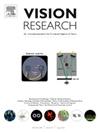区分中心选择偏倚和中心注视偏倚:视网膜偏心在视觉选择中的作用
IF 1.4
4区 心理学
Q4 NEUROSCIENCES
引用次数: 0
摘要
早期的研究表明,眼睛更倾向于选择靠近中心注视点的刺激,而不是远离中心注视点的刺激,这表明存在中心选择偏差。然而,到目前为止,研究已经混淆了视网膜偏心与距离显示中心的距离,因此观察到的影响可能是由所谓的中心注视偏差驱动的,这是对显示中心附近的物品的偏好,而不是视网膜中心。本研究旨在分离中心选择偏差和中心注视偏差,并揭示其时间过程。在两个实验中,参与者被要求对同时呈现的两张单张图片中的一张做一次眼球运动。单子总是在距离显示器中心相同的距离上呈现(从而控制中心固定偏差),但它们相对于初始固定点的偏心是不同的(从而允许中心选择偏差的操作)。当两个单品以不同的偏心位置显示时,参与者倾向于选择最近的一个。这种中心选择偏差发生迅速而短暂,在230毫秒左右达到峰值,并持续到大约320毫秒后显示开始。总之,这些结果表明,当多个物体竞争选择时,视网膜偏心是一个主要因素。本文章由计算机程序翻译,如有差异,请以英文原文为准。
Distinguishing a central selection bias from a central fixation bias: The role of retinal eccentricity in visual selection
Earlier work has shown that the eyes preferably select stimuli that are presented close to central fixation over stimuli presented further away, suggesting the existence of a central selection bias. However, so far studies have confounded retinal eccentricity with distance from the center of a display, and the observed effects may thus have been driven by what is known as the central fixation bias, which is the preference for items near the center of a display rather than the center of the retina. This study aimed to dissociate the central selection bias from the central fixation bias, and to uncover its time course. In two experiments, participants were instructed to make a single eye movement to one of two simultaneously presented singletons. The singletons were always presented at the same distance from the center of the display (thus controlling for the central fixation bias) but their eccentricity relative to the initial fixation point was varied (thus allowing for a central selection bias to operate). When the two singletons were displayed at different eccentricities, participants preferred selecting the nearest item. This central selection bias occurred rapidly and transiently, peaking around 230 ms and lasting until approximately 320 ms after display onset. Together, these results suggest that retinal eccentricity is a major factor when multiple objects compete for selection.
求助全文
通过发布文献求助,成功后即可免费获取论文全文。
去求助
来源期刊

Vision Research
医学-神经科学
CiteScore
3.70
自引率
16.70%
发文量
111
审稿时长
66 days
期刊介绍:
Vision Research is a journal devoted to the functional aspects of human, vertebrate and invertebrate vision and publishes experimental and observational studies, reviews, and theoretical and computational analyses. Vision Research also publishes clinical studies relevant to normal visual function and basic research relevant to visual dysfunction or its clinical investigation. Functional aspects of vision is interpreted broadly, ranging from molecular and cellular function to perception and behavior. Detailed descriptions are encouraged but enough introductory background should be included for non-specialists. Theoretical and computational papers should give a sense of order to the facts or point to new verifiable observations. Papers dealing with questions in the history of vision science should stress the development of ideas in the field.
 求助内容:
求助内容: 应助结果提醒方式:
应助结果提醒方式:


